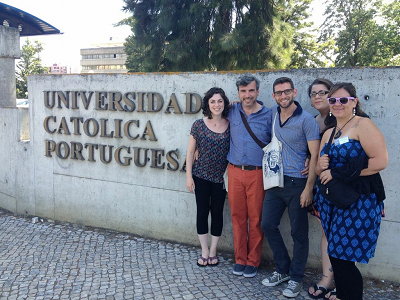Peter C. Hauser, associate professor at the National Technical Institute for the Deaf and director of NTID’s Deaf Studies Laboratory, spent part of this summer in England to help broaden the participation of deaf students in sign language research.
Thanks to a $34,000 mentorship grant from the National Science Foundation, Hauser was able to take six deaf students with him who are likely to become sign language researchers to participate in the “Sign Language Researchers Toolkit” workshop hosted by the University College London.

Peter Hauser and students at conference in Portugal
The students presented in the 11th Theoretical Issues in Sign Language Research Conference there, and were joined by Kailea Colayori, an RIT/NTID American Sign Language-English Interpretation graduate from Rochester. The grant also covered the costs for American Sign Language interpreting at the workshop and conference.
“The number of deaf people studying sign languages is very low compared to the number of hearing people who are conducting sign language research in educational linguistics, psycholinguistics, neurolinguistics, theoretical linguistics, and such,” Hauser says.
A committee of top linguistics teachers selected the six students who accompanied Hauser: Erica Israel, a psychology major at RIT/NTID from Concord, Mass.; Jessica Contreras, a psychology major at RIT/NTID from Anchorage, Alaska; Adam Stone, a professional and technical communications major who graduated from RIT/NTID in 2004 and is currently a Ph.D. student at Gallaudet University; Paul Twitchell, who attends the University of New Mexico; Rachel Benedict, who attends Boston University; and Lynn Hou, who attends the University of Texas, Austin.
When the London conferences concluded, Israel, Contreras, Colayori, and Stone traveled with Hauser to Lisbon, Portugal, to present at the 6th Deaf Academics Conference, which focused on issues faced by deaf scholars in academia and the deaf participants had the opportunity to present their scholarly work.
After their mentored summer experience, the students are expected to “give back to the community” by talking with younger deaf students about sign language linguistics through newsletters and school presentations and to recruit young deaf scholars into the fields that involve sign language research, Hauser said.
“Dr. Hauser, with his NSF mentoring grant, made it possible for me to attend the conference, which in itself was a marvelous opportunity,” Stone said. “We covered everything from documentation of emerging sign languages and creation of corpus databases to psycholinguistic and neuroscience experimental approaches. Without Dr. Hauser’s support, I would not have been able to attend.”
Source: https://www.ntid.rit.edu/news/conferences-encourage-more-deaf-students-sign-language-research

